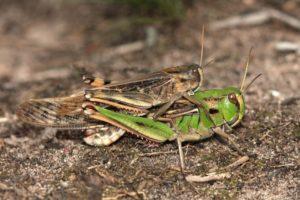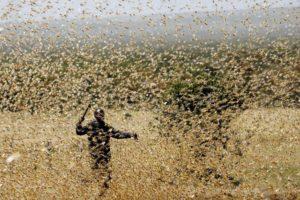What does a locust look like: photo and description of a dangerous voracious insect
The locust is an insect that everyone is familiar with in one way or another. Even city dwellers, who rarely go outside the city, most likely heard about the terrible invasions of hordes of these insects, because they can not only harm the crop, but also lead to the decline of the economy of many countries.
Content
What does a locust look like
Name: Real locust
Latin: Acrididae
Class: Insects - Insecta
Squad: Orthoptera - Orthoptera
 | Habitats: | everywhere except Antarctica |
 | Dangerous for: | almost any vegetation |
 | Means of destruction: | insecticides, prevention |
The locust family includes more than 10 thousand different species. The most dangerous among them is the desert locust.
Outwardly, locusts are very similar to grasshoppers, but their main distinguishing feature is small and strong antennae, consisting of 19-26 segments. The length of the body of an insect, depending on the species, can vary from 1,5 to 20 cm.
The color of the locust also has different variations - from bright yellow to dark brown. The hind wings are translucent and can be painted in a bright, contrasting color, while the front wings most often completely repeat the color of the body.
Locust habitat
Due to the wide variety of species, representatives of the locust family can be found almost all over the world. These insects live on all continents except Antarctica. The climatic conditions of the locust are also not particularly frightening. It can be found in tropical, temperate and even harsh continental climates.
The presence of dense vegetation and humidity also does not particularly affect the spread of locusts. Some species feel great in arid and desert areas, while others in grassy thickets on the banks of reservoirs.
What is the difference between a locust and a filly
A distinctive feature of this family of insects is their division into solitary grasshoppers and gregarious locusts.
These species have external differences and lead a completely different lifestyle, but they are just different phases of one insect.
What is dangerous locust
The gregarious phase of the locust is the main threat. At this stage, quiet and calm insects literally turn into a "natural disaster". They destroy almost all vegetation in their path and are able to travel long distances daily in search of food.
Locust swarms are completely picky in food and do not leave behind leaves or stems of green plants. According to scientists, the average swarm of locusts destroys on its way such a number of plants that would be enough to feed more than 2000 people during the year.
The worst thing is that it is quite difficult to overcome such an invasion. These flying insects spread too quickly and the only way out, and not particularly safe, is to spray insecticides from the air.
What types of locusts can be found on the territory of Russia
The number of locust species is simply huge and some of them can be found in different regions of Russia. The most common among them are:
- Moroccan locust;
- migratory Asian locust;
- desert locust;
- Italian locust;
- Siberian filly;
- Egyptian filly.
Methods of struggle
Locust on the site acts mercilessly. She very quickly eats almost any planting. It is impossible to choose simple methods of struggle, because it spreads with lightning speed.
Locusts are often confused with grasshoppers, so do not start a timely fight. But in such a situation, delay can cost the harvest.
Conclusion
There are a huge number of various garden pests in the world, but none of them is capable of causing such enormous damage as locusts. Numerous flocks of these small insects have been destroying human crops for many millennia and causing starvation of entire settlements.
Previous
